Vol 5 No. 46 TROPIC LIGHTNING NEWS November 30, 1970
Index
| Unit Page | Unit Page | Unit Page | Unit Page |
| 1/5 Photo 1 | 2/14 2 | 3/13 Arty 2 | 4/23 Photos 7 |
| 1/5 3 | 2/22 2 | 4/9 2 | 44th Scout Dog 2 |
| 1/5 6 | 2/27 Photo 1 | 4/23 Photo 2 | 668 RF Photos 4 |
| 1/5 8 | 2/27 2 | 4/23 2 | 7/11 Arty 2 |
| 1/5 Photo 8 | 2/27 3 | 4/23 6 | Donut Dollies 2 |
| 1/27 8 | 2/27 Photos 3 | 4/23 Photo 6 | Nui Ba Den Photos 4 |
| 2/12 8 | 3/4 Cav 8 | 4/23 7 | Nui Ba Den 4 |
HISTORY MARCHES ON - PAGE 2
|
|
Page 2 TROPIC LIGHTNING NEWS November 30, 1970
 |
As Troop
Redeployment Continues
Units Reflect Colorful Post
CU CHI - Units with their boots planted firmly
in history, who have done battle in places whose names head important chapters
in the American chronicles of war, continued to stand down at Cu Chi as part of
the 5th increment of troop redeployment from Vietnam.
The Little Big Horn, Gettysburg, Fredericksburg, Antietam, Ardennes-Alsace,
Normandy -- battle streamers knotted on standards tell the story.
It was the 2nd Battalion, 14th Infantry who stood toe to toe with the Rebels
in the fields of Pennsylvania during the Civil War. It was the 2nd Battalion (Mech),
22nd Infantry, who rode with Custer against Sitting Bull. The 2nd Battalion,
27th Infantry were first tested against the Russian Communists in 1918.
Other units standing down during the week, were the 3rd Battalion, 13th
Artillery; 4th Battalion, 9th Infantry; the 7th Battalion, 11th Artillery and
the 44th Infantry Scout Dog Platoon.
When General George G. Meade, commander of the Army of the Potomac, was asked
where the 2nd of the 14th should be placed in a grand review at the end of the
Civil War, he said: "To the right of the line, the 14th has always been to the
front of the battle and deserves the place of honor."
The Golden Dragons arrived in Vietnam in April, 1966. The battalion has
earned ten campaign ribbons since that time, including those for all six
Counteroffensive Phases, and the Tet Counteroffensives of 1968 and 1969. In
addition, the unit has been awarded the Vietnamese Cross of Gallantry and the
Vietnamese Civil Action Medal.
In May, 1970, the Dragons participated in the Tropic Lightning's thrust into
Cambodia. Most recently, the unit has been operating near Dau Tieng and the
Razorback Mountains.
Triple Deuce was formed in 1966 to fight the Indians in the West. In 1898,
it was the first US unit on Cuban soil during the Spanish-American War.
The Mechmen arrived in Vietnam in September, 1966, and have since taken part
in Counteroffensive Phases II through VI and the Tet Counteroffensives of 1968
and 1969. The unit has also earned a Presidential Unit Citation, a Vietnamese
Cross of Gallantry and a Vietnamese Civil Actions Medal for its effort here.
In May of this year, the mechanized battalion roared into Cambodian to take
part in the division's operations there.
The Wolfhounds of the 2nd of the 27th were formed in 1901 and took their
nickname from the Russian dog noted for its ferocity in battle. In 1941, the
unit joined the 25th Division and subsequently fought in the Pacific Theater
during World War II.
In January, 1966, the Wolfhounds arrived in Vietnam and helped secure and
establish the Tropic Lightning base camp at Cu Chi. During their time here, the
battalion has earned three Presidential Unit Citations, a Valorous Unit
Citation, a Vietnamese Cross of Gallantry and a Vietnamese Civil Action Medal.
When the division moved units into Cambodia in May, the Hounds were among them.
The 7th Battalion, 11th Artillery was organized in 1917 and saw action in
World Wars I and II and in Korea.
The On Time battalion came to Vietnam with the division in 1966. They have
earned two Presidential Unit Citations, a Valorous Unit Citation, a Vietnamese
Cross of Gallantry and a Vietnamese Civil Action Medal for RVN efforts.
The 3rd of the 13th saw action in World War 1, in the European Theater during
World War II and in Korea before coming to Vietnam in April, 1966. Since coming
here, the unit has provided fire support during operations conducted by the 25th
Division, including those against enemy sanctuary areas in Cambodia this year.
They have been awarded the Presidential Unit Citation, Valorous Unit Award,
the Cross of Gallantry with Palm and the Vietnamese Civil Action Medal since
arriving here.
The 44th Infantry Scout Dog Platoon was formed during this war and has
received a Presidential Unit Citation, a Vietnamese Cross of Gallantry and a
Civil Action Medal.
By the middle of December, two full brigades of the 25th Division will have
been redeployed. At that time, American strength in Vietnam will have been
reduced to 344,000.
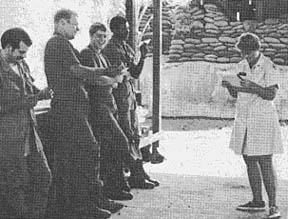 |
THE ACTORS - Infantrymen of the 4th Battalion (Mech), 23rd Infantry try their hands at "acting" during a Wild West Program directed by Red Cross Representatives Suzi Blatchford of Chicago, and Pat Rowan of Houston. |
Tomahawks Play Host As
Donut Dollies Visit
By PFC WAYNE DANLEY
XUAN LOC - Recently, the "Tomahawks" of the 4th
Battalion (Mech), 23rd Infantry played host to a pair of 25th Division Red Cross
girls. Taking time out from their redeployment activities at the Husky
Compound, the 4/23rd troopers enjoyed an hour long program on the "Wild West."
The first of the three part program saw the girls quizing the men about
recent "cowboy" movies and Western-style TV shows.
During the second phase of the program, the girls asked questions to two
teams of GI's. The correct answer allowed a trooper to participate in a ring
toss game which was the only way points could be scored.
What was the name of the Cisco Kid's horse? Who was the Indian princess that
led the Lewis and Clark expedition through the treacherous lands of her tribe?
What was Annie Oakley's brothers name in the TV series? What outlaw was hung
twice? Who was known as the hanging judge? These are but a few of the
questions that the "Tomahawks" were asked. Also - Why did the Indians get to
America first? (all Tomahawks should know the answer to that one!) Because they
had reservations, of course!
The score of the contest was kept fairly close because of "helping" Red Cross
girls and GI's who were a little rusty in their ring tossing. One trooper (nine
months in Vietnam) said, "I threw the rings wild so I could get a better view of
the girls bending over when retrieving them."
The third and final part of the program saw eight "Tomahawk" actors take the
stage and participate in a Western Melodrama. Their acting skills were also a
little rusty, but everyone seemed to enjoy it, including the "rookie" actors.
Specialist 4 Rich Geniesse from Menominee, Mich. said, "The program seemed to
be a real moral booster. It helped relax everyone by taking their minds off of
the problems in the field."
Red Cross girls Pat Rowan of Houston and Suzi Blatchford from Chicago present
weekly programs to GI's all over the 25th Division.
Suzi, who proved herself an able football player in a short scrimmage before
the program started, explained that a lot of work and preparation goes into
constructing an original and presentable program.
Pat, a policewoman back in the world, stated that the hour programs are
intended to take the troops minds off of where they are.
Suzi, who will be home by the time this article is printed, said when asked
of her year here, "It has been a really interesting and challenging year, but
I'll be glad to get home."
As for the question everyone always asks, "What is a girl like you doing in a
place like this?" Suzi says, "Most of the time I answer - Because you are
here. But sometimes I tell them that I got on the wrong bus."
The TROPIC LIGHTNING NEWS is an authorized publication of the 25th Infantry Division. It is published weekly for all division units in the Republic of Vietnam by the Information Office, 25th Infantry Division, APO San Francisco 96225. American Forces Press Service and Army News Feature materials are used. Views and opinions expressed are not necessarily those of the Department of the Army. Printed in Tokyo, Japan, by Pacific Stars and Stripes.
MG Edward Bautz, Jr . . . . Commanding General
MAJ Robert E. Kelso . . . Information Officer
1LT Martin E. Webb . . . . Officer-in-Charge
SP5 William M. Lane . . . . Editor
SP4 Scott Watson . . . . . . Assistant Editor
SP4 Michael Winston . . . Production Supervisor
BATTALION CORRESPONDENTS
| SGT Derr Steadman SGT Mike Bailey SGT Bryon Fites SGT Mark Rockney SGT Mike Conroy SGT Daniel House SGT Jack Strickland SGT Dan Davis SGT Bob Lodi SP5 Tom Watson SP5 Doug Sainsbury SP4 Frank Salerno SP4 Tom Benn SP4 Greg Duncan |
Discom 4/23 4/23 2/12 3/4 Cav 4/9 1/27 1/27 1/5 725th 2/77 2/22 7/11 2/27 |
SP4 John Corbin SP4 Rich Erickson SP4 Ed Toulouse SP4 William McGown SP4 James Duran SP4 Kris Peterson SP4 Frank Morris SP4 Phillip Maslin PFC Dan Lowry PFC James Stoup PFC Doc Polis PFC Dan Danley PFC Mike Roberts PFC Richard Haley |
1/5 2/14 2/12 Divarty 3/13 3/22 2/34 2/27 2/27 65th Eng 269th 4/23 4/23 1/8 |
Page 3 TROPIC LIGHTNING NEWS November 30, 1970
Historical Unit
Stands Down
Wolfhounds Accomplish Vietnam
Mission
By SP5 STEVE KROFT
CU CHI - When the 2nd Battalion, 27th Infantry
(Wolfhounds) waded ashore with the rest of the 2nd Brigade of the 25th Infantry
Division at Vung Tau in January of 1966, Cu Chi district belonged to the Viet
Cong.
As late as August, 1965, enemy units staged victory parades down Highway 1
through the center of Tan An Hoi. The plot of land north of the village of Cu
Chi that would one day become "Tropic Lightning" Headquarters, was little more
than a series of bamboo thickets overgrown with vegetation and honeycombed with
enemy tunnels.
Last week, more than five and a half years later, the battalion stood in
front of an elaborate division headquarters in pressed fatigues and spit-shined
boots to be told by the commanding general of the 25th Division that their
mission in Vietnam had been accomplished.
The 2nd Wolfhounds, one of the Army's proudest units, was officially at "zero
strength", its members scattered about as a result of the fifth increment of US
troop redeployment from Vietnam.
After inspecting the troops and presenting a few final awards for heroism,
Major General Edward Bautz mounted the reviewing stand to deliver a short
speech.
"We are gathered here today", he said, "to commemorate a milestone: the
achievement of the mission that we set out to accomplish when we first came to
this country."
"When the members of your organization arrived here, the VC used to have
meetings in a catholic church just outside the point where the main gate stands
today. We all know that it doesn't look like that now and your contribution has
been a significant one."
Besides praising the Wolfhound's fine combat record, General Bautz cited
contributions made by the battalion in pacification and Vietnamization; criteria
established by President Nixon for successful troop redeployment.
The battalion traces its beginnings back to the old 27th Infantry Regiment
which was established in 1901. The regiment saw its first combat against the
insurgent Russians on the eastern front of World War I becoming one of the first
American units to fight communism. Its nickname "Wolfhounds" was taken from the
Russian dog noted for its ferocity.
In 1941, the regiment joined the newly formed 25th Infantry Division at
Schofield Barracks, Hawaii, and subsequently fought in the Pacific theatre
during World War II.
The 27th Regiment again fought with the 25th Division in Korea. Under the
command of Lieutenant Colonel John H. "Mike" Michaelis, now Commanding General
of US Forces in Korea, the regiment established a reputation as one of the
finest combat units in the Army, participating in ten campaigns and receiving
four Republic of Korea Presidential citations.
In 1963, the Army did away with the regimental concept under the ROAD
organization plan. The 1st and 2nd Battalions of the 27th Infantry were
assigned to the 2nd Brigade of the 25th Division. A third "Wolfhound" battalion
was activated in and assigned to the 4th Brigade of the 25th Division now
assigned to Schofield Barracks.
From, the time the 2nd Battalion, 27th Infantry arrived in Vietnam they have
participated in nearly every significant operation carried out by the 25th
Division.
In January of 1966, the battalion helped secure and establish the Tropic
Lightning base camp here. For three weeks they flattened vegetation, dynamited
tunnels, and flushed out enemy snipers in what is now referred to as the "Battle
for Cu Chi."
They have participated in Vietnam Counteroffensive Phases I through IV and
the Tet counteroffensives of 1968 and 1969.
Between February and April of 1969, the battalion killed 545 enemy soldiers
at patrol bases Diamond I, Il and III. These operations have come to be
considered among the most tactically successful of the Vietnam conflict.
On February 23, 1969, in the midst of country wide attacks on allied bases,
the North Vietnamese assaulted patrol base Diamond I.
The attack was planned by doctrinaire NVA officers as a conventional assault
by regular troops against what appeared to be a tactical island isolated from
the heavy guns and rapid reinforcements of the allied army.
But long range artillery and the quick response of armed helicopters and Air
Force gunships put up a wall of fire around patrol base Diamond, inflicting
staggering casualties on the enemy.
In the next two months, the 2nd Wolfhounds constructed two more patrol bases
along the border. Each time the results were the same: the NVA were no match
for allied firepower.
In May of 1970, the unit participated in the Cambodian operations of the 25th
Infantry Division. More recently, the battalion has been working the heavily
booby trapped area known as the "Mushroom."
During their time in Vietnam, the battalion has earned three Presidential
Unit Citations, a Valorous Unit Citation, a Vietnamese Cross of Gallantry and a
Vietnamese Civil Action Medal.
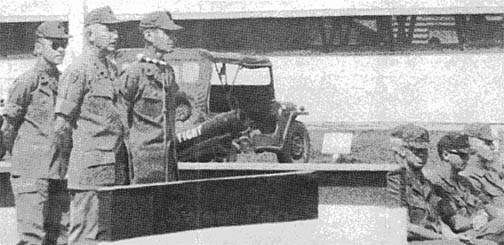 |
END OF AN ERA - Major General Edward Bautz, Jr (center platform) commanding general of the 25th Infantry Division delivers his closing remarks to the 2nd Battalion 27th Infantry "Wolfhounds" during their standdown ceremony held here recently. |
| THE DIAMONDS - Small patrol bases, barely 125 meters across, constructed on an open plain near the Cambodian border. They were to serve as a deterrent to enemy infiltration, but also, they were to appear vulnerable enough to entice the enemy into large scale ground attacks. |
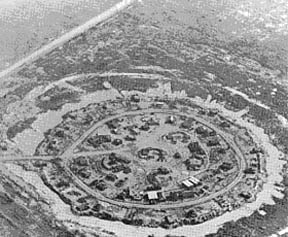 |
Charlie Goofs
Again
Bobcats Discover Cache
By SGT BOB LODI
BEARCAT - It had been a rough two days for the
men of the 2nd Brigade, 1st Battalion (Mech), 5th Infantry.
The men of Charlie Company had just dropped their sweat soaked rucksacks and
sighs were plentiful in the noon heat. Rest, however, was not to be had.
Approximately five klicks away some foolish VC engaged two UH-1 helicopters with
small arms fire. The choppers returned fire and called in a light fire team.
The first platoon of Charlie Company was the closet element of ground troops,
so they were alerted to saddle up. Soon three choppers were on the ground
picking up the Bobcats for an air insertion into the contact area.
The choppers touched down about fifty meters from the contact area and the
men split up into two groups and began a sweep. Sergeant Larry Davis of
Vincennes, Ind., was walking point for one group when he came across a body
lying in the weeds.
"It startled me," He said, "I fired out of reflex."
The VC was already dead, killed by the light fire team. Moving on, Davis
spotted a bunker with two more bodies to the side of it. While Davis was
checking the bodies out, Specialist 4 David Wood of Salem, Virginia, and
Specialist 4 John Watson of Phoenix, Arizona, entered another bunker. Their
search was abruptly halted as they came scrambling out, firing back into the
bunker.
"We were looking under the floor boards and we found a pair of boots trying
to crawl further up under the floor," said Watson. Needless to say the boots
and the floor boards stopped moving.
The two sweep elements married up, the choppers landed and the Bobcats were
inserted again, this time about 400 meters from the first landing zone.
Beginning another sweep, the men found a 55-gallon drum filled with rice, and a
case of rifle grenades. This plus the one AK-47, RPG and launcher, M-1 carbine,
Chicom pistol and stack of documents recovered from the bodies near the bunker
complex made for a tidy haul.
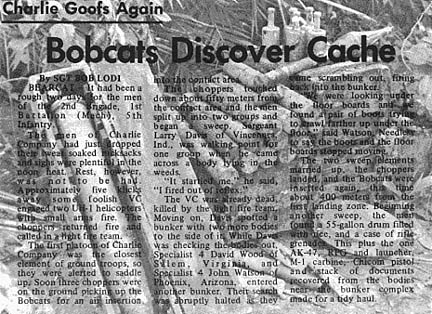 |
Page 4 - 5 TROPIC LIGHTNING NEWS November 30, 1970
|
|
Nui Ba Den
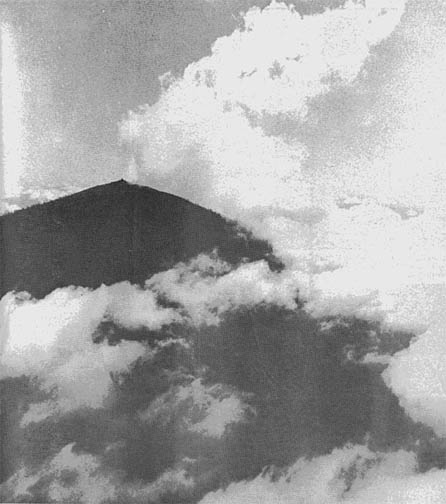 |
| 4 BLACK JEWEL, AN AGING BEAUTY - From a distance, the Black Virgin Mountain appears majestic, an aging cloud covered queen reigning silently over an ancient land. |
By SP5 STEVE KROFT
The 25th Division's Vietnam history is laced with geographical locations that
seem to have appeared almost overnight, enjoyed a fleeting moment of prominence,
and then ceased to exist. Places like Fire Support Bases Kotrc and Crook,
Sharron and Dorn, Frontier and Mole Cities.
The only stationary reference point in the otherwise protean area of
operations has been Nui Ba Den.
From a distance, the Black Virgin Mountain appears majestic, slightly erotic,
out of place: a black silhouette against blue sky and green rice paddy. But
like an aging beauty, she begins to show her years when you draw closer.
Scarred and craggy from years of bombing and shelling, that stately black coat
turns to the muddy green of scrub brush and undernourished pine.
The mountain has been described as an island cut loose from the war. Nowhere
is this more evident than at the summit, where a group of 25th Division Soldiers
have defended a signal relay site since 1967.
There is a notable absence of base camp atmosphere and the noise of the fire
support base. At one time, the mountain was isolated from the rest of the
world, save telephone communication and helicopter resupply, but today,
television has made it a full fledged member of Marshall McLuhan's global
village.
On a clear day you can see down across the Boi Loi and Ho Bo Woods, past Cu
Chi to Saigon. By night, the bunker guards command an impressive view of the
countryside. From their vantage point they are able to see artillery fire and
then report miles away, tracer rounds crawl along the flatlands as if traveling
in slow motion.
But at night, beautiful sights are overpowered by sinister sounds. Noises
made hundreds of meters down the slopes ride the updrafts and seem only a few
yards away, serving as a constant reminder of the shaky coexistence on the
mountain.
For the past three years, the security for the signal relay site at the
summit has been provided by the men of the Nui Ba Den Provisional Company, its
soldiers literally defending their own doorsteps, fighting off the VC recon
elements that periodically probe the defenses.
Through the years, the Japanese, French, Viet Minh and Viet Cong have all
held the summit at one time or another. Today the only evidence that remains of
those earlier occupants is the inevitable collection of names carved into rocks
and a few stumps cemented firmly and neatly onto the mountain.
Recently, the Provisional Company stood down as part of the fifth increment
of US troop redeployment from Vietnam and the responsibility for the defense of
the mountain was quietly turned over to the Vietnamese.
Fittingly enough, as a final gesture, the division crest was carved on one of
the rocks at the summit. According to Major Frank Johnson of Tampa, Fla., the
Provisional Company's commanding officer, the insignia is cut one-quarter of an
inch deep in solid granite. "The Vietnamese," he said, "say it will last 50 to
100 years."
The mountain, unless man discovers a way to move them, will last considerably
longer.
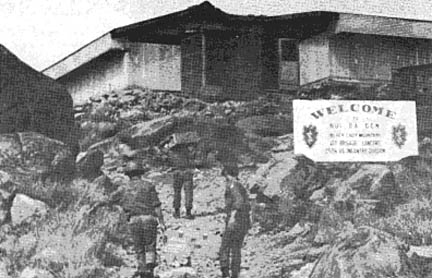 |
A LADY WELCOMES YOU -- Struggling up the mountain top path, these 688th RF troops are greeted by the 25th's Black Lady Mountain Welcome Mat, as they move in their equipment to take over the hilltop's defense. |
| UP THE HILL - Luggage, guitars and rucksacks are lugged up this rock strewn trail, as these 688th RF troops, piling out from the entrails of a Chinook, prepare to take up the defense of Nui Ba Den's summit. |
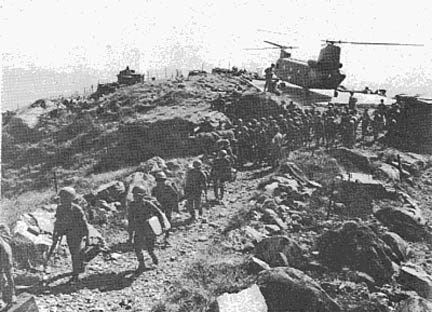 |
Page 6 TROPIC LIGHTNING NEWS November 30, 1970
Tomahawks Believe Good
Luck Charms
By PFC MIKE ROBERTS
XUAN LOC - Is there such a thing as good luck?
Troopers of the 4th Battalion (Mech) 23rd Infantry believe that there is and
carry good luck charms that prove it!
The "Tomahawk" infantrymen tote a wide variety of charms for good luck with
them. These range from nude pictures of their girls to Mickey Mouse Fan Club
cards. For example, when asked, peace symbols, love beads, bracelets, Kennedy
half-dollars, silver dollars, grenade rings, and bush hats were mentioned to
name a few.
Others included a two-dollar bill which Sergeant George J. Sousan said, "Is
supposed to be bad luck for gamblers, but it has proved to be the opposite for
me."
Specialist 4 Charles R. Hawk from Dayton, Tenn., a squad leader with Bravo
Company, keeps a cap from a bottle of Tennessee "sour mash" whiskey in his
pocket and swears by it.
Staff Sergeant Robert D. Nichol from San Antonio, Tex., wears a chain with
monkey, dog, and shark teeth on it, given to him by the Derrian Indians in
Panama for his protection.
Sergeant Jimmy Lawson from Dallas, was given a rabbit's foot by his father
before coming to Nam.
He said, "It has definitely been good luck for me. I have to put talcum
powder and after shave lotion on it to keep the obnoxious odor at a minimum, but
its been worth it."
Sergeant Rick Connell sports the left eyeball of the rare "Thumping Lynx" on
a key chain as his good luck charm.
The most popular good luck charm carried by the infantrymen of the "Tomahawk"
Battalion was found to be the religious cross.
Specialist 4 George Jackson from Vicksburg, Miss., said, "I think we all can
agree that all the good fortune we experience is ultimately a result of the Man
above looking after us."
| SCOUT LUCK -- Members of the 4th Battalion (Mech), 23rd Infantry, Charlie Company's command track (APC) carry Kit Carson Scout Pham Van Phuoc, who has proven to be good luck for them. (Photo by PVC Mike Roberts) |
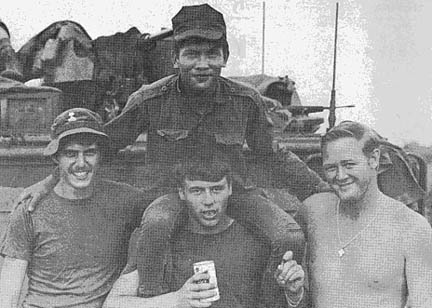 |
Sweet Pea - She's Old
But She's Got Class
By SP4 JOHN CORBIN
BEARCAT - She has been adopted and orphaned many
times. The names of at least six states are scrawled on her sides along with
Diane, Nancy, Sonia, Elenor, and Jane. There's a neatly lettered "Made in
Japan" in one corner, an official looking 42 in another, and several embedded
AK-47 rounds in yet another. But the most outstanding feature is the carefully
centered drawing of "Sweet Pea" from which she gets her name.
Sweet Pea is the oldest Armored Personnel Carrier (APC) in the 1st Battalion
(Mech), 5th Infantry. She recently saw her fourth year in Vietnam, since coming
in-country with the Battalion's Alfa Company in 1966.
"Sweet Pea is a gun track in the weapons platoon and it undergoes less wear
and tear than line tracks," said her present driver, Specialist 4 Mark Kelly of
Battle Creek, Mich.
Even so, the APC has better than 9000 miles on its log book with few major
break-downs. It continues to operate well despite jokes like, if the caked mud
were washed off the sides would collapse.
Sergeant James Schryer of Menominee Fall, Wis., her DEROSing squad leader,
seems to sum up his squads feelings about the "old" track with his comment, "if
you take care of Sweet Pea, she'll take care of you."
Ask SGT Certain
Dear Sgt. Certain,
When I enlisted for 6 years, my recruiting sergeant promised that I would be
guaranteed my chosen MOS. I signed up for 234Z 10, Field Sanitation Receptable
Maintenance. In other words, I replace the screen covers on the P-P tubes each
month. Contrary to popular belief, there's only ONE drawback to my particular
MOS. P-P tubes are native only to RVN war zones. Now that American troops are
being withdrawn, I will soon be out of a job. I had hoped to be a career man
and some day become NCOIC of the entire Vietnam FSRM operation. I am faced with
a real dilemma. This is the only vocation I am trained for and I am afraid to
go back to civilian life. I would be an outcast and end up unemployed. Can
this be avoided?
Pvt. Pillgrin
Dear Carl,
I can see why you take such pride in your profession. Every GI in Vietnam
has gazed happily upon your handiwork. I took your story of woe to the Chief of
Staff and he suggested we have a P-P tube bronzed and mounted so that you may
hang it proudly on your living room wall. It will make a swell conversation
piece and in fact you could charge admission. That would take care of your
unemployment problems and also it would serve as a constant reminder that the
army takes care of its own.
Dear SGT Cretin,
Now that the dry season is upon us (to coin a phrase), why has the mess hall
discontinued the practice of providing milk and cups for our meals. I hate
drinking ice tea with a plastic fork.
PFC Silbercup
Dear Bob,
Considering the consistency of mess hall ice tea, you probably need a knife
as well as a fork to eat it. Have you ever tried drinking their jello? It
works much better.
Page 7 TROPIC LIGHTNING NEWS November 30, 1970
Ensuring Battalion
Security
Radar Surveillance Locates
Charlie By Ear
By PFC WAYNE DANLEY
OPERATION BASE LYNCH - Working as a ground
surveillance team to ensure the security of a battalion is the main function of
the radar platoon assigned to the 4th Battalion (Mech), 23rd Infantry.
Staff Sergeant Wenceslao Longoria of Austin, Tex., radar section leader,
said, "We work together with S-2 and the Battalion Commander (LTC Edward
Bradford) here at Operation Base Lynch in direct support of the battalion.
There are also two additional radar teams that work in the field with the
"Tomahawk" line companies."
Two of the three available portable pact surveillance units are used as audio
detectors and the third can be used for both audio and visual purposes. Each
unit is capable of 360 degree coverage, although a designated sector of the
surrounding area of operation (AO) is usually assigned.
The radar is used mainly for defensive purposes, but can also be used
offensively, on patrols and ambushes, although this is rarely done. By using it
to scan roads to prevent the planting of enemy mines, it has proven
exceptionally valuable to mechanized units.
The radar unit at Lynch can "pick up a man" 5000 meters away and a vehicle
10,000 meters away.
"A moving man makes the sound of someone walking on snow. By listening to
our radar equipment, you can estimate the number of people, how fast they are
moving, and whether they are moving towards or away from you," said Specialist 4
Richard Moore, from Albuquerque, N.M.
The screen allows an alternate method for detecting enemy targets. Either
method (audio or visual) allows the operator to determine an azimuth to the
movement and also determine the approximate range.
"We check with S-2 before setting up the unit each night for a schedule of
patrols, ambushes, and other friendly operations in the area under
surveillance," said Sergeant Sal Quince, from Long Island, N.Y. When a target
is spotted, the type of target, azimuth to the target, and range is reported to
S-2.
Next, the Brigade perimeter defense is notified and they obtain the necessary
artillery clearances.
A radar team consists of a minimum of three men who are on duty a total of
four hours a night, but no more than one-half to one hour at a time.
The men also have to perform daily maintenance on their equipment. This
includes charging batteries, checking fuses, cables, and cable heads, and
lightly oiling the units. The equipment, aside from being very valuable, is
very delicate. The preferred method of transporting is by chopper.
Once in Cambodia, at 4:30 in the morning, the radar spotted an estimated 30
individuals in a gully a short distance from a night defensive position.
Mortars were called in on the suspected enemy position and the radar showed
increasingly less activity until none was detected whatsoever. In that
instance, the use of radar undoubtedly foiled an enemy ambush.
| CHECKING IT OUT - A radar specialist of the "Tomahawks" tests his set while getting ready for the night's operation at Operation Base Lynch. (Photo by PFC Wayne Danley) |
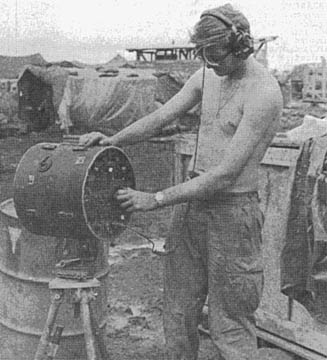 |
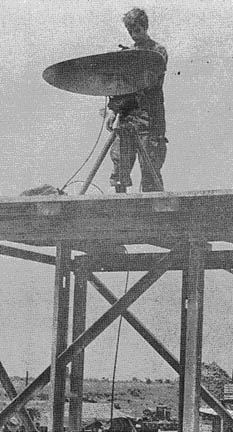 |
SET UP - Sergeant Sal Quince of Long Island, N.Y., a member of the 4th Battalion (Mech), 23rd Infantry "Tomahawks" orients his radar set getting ready for the night's operation at Operation Base Lynch. (Photo by PFC Wayne Danley) |
| GETTING A CHARGE - A radar man of the 4th Battalion (Mech), 23rd Infantry charges batteries for his radar unit at Operation Base Lynch. (Photo by PFC Wayne Danley) |
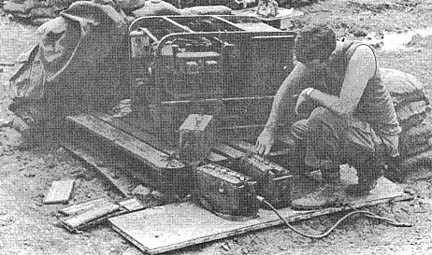 |
Page 8 TROPIC LIGHTNING NEWS November 30, 1970
Bobcat's APCs Must
Always Work
Driver,
Gunner See They Do
BY SP4 JOHN CORBIN
BEARCAT -- In a mechanized infantry unit such as
the 2nd Brigade's 1st Battalion (Mech), 5th Infantry operational Armored
Personnel Carriers (APC) are essential for successful missions. In the field an
operational APC is the responsibility of the driver and the .50-caliber machine
gunner.
Maintenance
"The most important part of a driver and .50-gunner's job is to maintain
their track in the field," said Specialist 4 John Hayes of Inverness, Miss., a
Delta (driver) for the Bobcats. "They're responsible for first echelon
maintenance but usually are involved with quite a bit more," he continued.
Such jobs as checking oil levels in the engine, transmission, and road wheels
and checking water levels in the radiator must be done daily. The driver
usually cannot rely on his gauges to tell him what's going on.
"Road wheels are usually changed in the field and a driver must look for
signs of worn road wheels and dead track blocks," said Specialist 4 Stephen
Carell, a driver from Alfa Company.
Contact
When in contact the driver and .50-gunner assume more responsibility for they
must bring the tracks firepower to its most needed area and also use the APC as
a shield for troops on the ground.
"In contact we drive from inside the track," said Specialist 4 Larry Warr of
Cleveland, Ohio, "otherwise we use the extension lateral and drive on top."
"The driver has to point the track towards the action because of the limited
turning radius of the .50-caliber machinegun," continued Watt. "He is also
supposed to keep pouring oil on the fifty to cool it and keep the gunner
supplied with ammo."
Miscellaneous
Drivers and gunners are men who have been on the track for five or six months
as ground troops.
Said Specialist 4 Mike Dembee, a driver with Bravo Company, "When I got off
the ground and began learning to drive it was like learning to ride a bike.
Judgment of speed, how to negotiate logs, rice paddy dikes, hills and streams
all had to be learned."
"However," said Private First Class George Yates of Stratford, Conn., a
.50-gunner, "It's not a complete bummer, for drivers and gunners do not have to
go out on ambush."
Mechanical Ambushes
Destroy Supply Route
By SGT MIKE CONROY
CU CHI - With the aide of the unerring
mechanical ambush, troops of the 3rd Squadron, 4th Cavalry, recently succeeded
in disrupting an enemy supply route north of here.
"Observation from the air had led us to believe that a certain area of the
Crescent was being used as an infiltration and resupply route," said Staff
Sergeant Raymond Lott of Miami, Fla., leader of the Cav's Flame Platoon.
Ambush sites and mechanical ambushes were set up all along the route each
night for a week. Although there were no fire fights by the men, the
mechanicals had a field day.
The claymores had accounted for four enemy dead, two AK-47 rifles, 30 lbs. of
rice and three VC rucksacks. Several blood trails were also found.
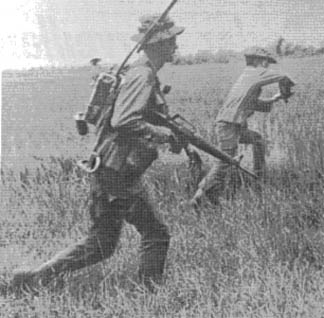 |
HURTLING RICE DIKES -- SP4 Wendell Witt of Bedford, Va., an RTO (radio telephone operator) with Alfa Company 1st Battalion (Mech), 5th Infantry and a member of a Regular Forces platoon chase after a fleeing Vietnamese farmer during a recent operation southwest of Bearcat. |
Tripflare Saves G.I.
Deflects Enemy Bullet
By SGT JACK STRICKLAND
CU CHI - There are a number of things that
happen to men in combat that just cannot be explained any way but "luck, no
matter how one looks at it. Some of these things just defy ordinary
explanation.
Such happenings as that funny feeling a grunt experiences just before his
unit comes under enemy fire, or those stories about soldiers whose lives were
saved when an enemy bullet was stopped by a Bible that the trooper kept in his
shirt pocket. Powers from above? Perhaps.
It would seem that some credit should be given to the people who make trip
flares too, because for Specialist 4 Palmer Walter, from Houston, a rifleman for
Company E, 1st Battalion, 27th Infantry "Wolfhounds," one played a vital role in
his tour here.
An enemy bullet slammed into his rucksack, was deflected by a trip flare and
slashed its way out the other side of the pack into thin air, missing its
intended victim by mere inches.
When the shooting stopped and Walter discovered the damaged flare, his first
reaction was one of disbelief.
"We were waiting to board the choppers when we took AK fire," stated Walter.
"He was a good shot. I was just lucky or something."
But it was finally conceded that the trip flare may have saved his life.
Warriors Are Last To
Leave
By PFC RAY CASSIDY
DAU TIENG - The 2nd Battalion 12th Infantry, a
recent addition to the 2nd Brigade, was the last US battalion to leave War Zone
C. Fire Support Base Jamie, their home since September was quietly turned
over to the 2nd Brigade 8th ARVN Regiment on October 30. The Warriors then
moved to the 1st Brigade's Dau Tieng Base Camp to await redeployment to 2nd
Brigade.
Thanks to:
Patrick Dalton, 1st Bn., 27th Inf.,
for sharing this issue,
Kirk Ramsey, 2nd Bn., 14th Inf. for creating this page.
This page last modified 06-19-2006
©2006 25th Infantry Division Association. All rights reserved